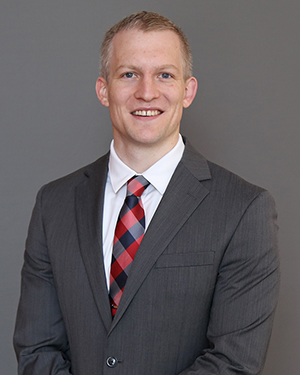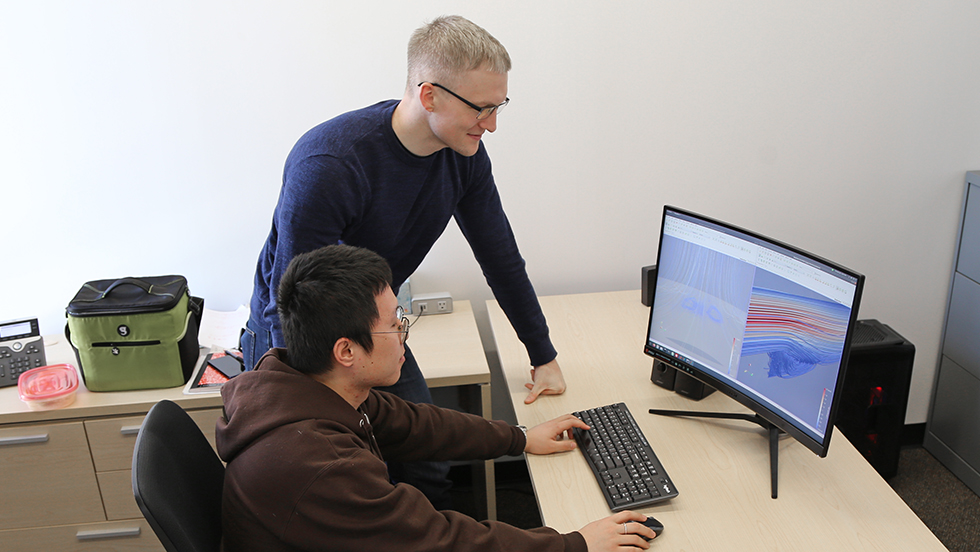Understanding complex fluids
Assistant Professor Jesse Ault looks to predict fundamental behaviors in complex fluids, an essential step to solving big picture challenges.
 As the newest addition to Brown Engineering’s Fluids and Thermal Sciences group, Assistant Professor Jesse Ault’s research combines classical fluid dynamics theory and experimental microfluidics to solve fundamental problems in multi-physics heat and mass transfer, with an emphasis on numerical simulations. The applications of his research range from the measurement and manipulation of particles and biomaterials (such as separations, detection, sorting, and filtration), to classical fluid dynamics theory for flow in bends and branching junctions.
As the newest addition to Brown Engineering’s Fluids and Thermal Sciences group, Assistant Professor Jesse Ault’s research combines classical fluid dynamics theory and experimental microfluidics to solve fundamental problems in multi-physics heat and mass transfer, with an emphasis on numerical simulations. The applications of his research range from the measurement and manipulation of particles and biomaterials (such as separations, detection, sorting, and filtration), to classical fluid dynamics theory for flow in bends and branching junctions.
“One of the fascinating aspects of fluid dynamics is that, despite the relatively classical nature of the field, we continue to develop new solutions, applications, and fundamental insights from the governing equations,” Ault said. “In areas like bio-fluids, advanced manufacturing and 3D printing, and lab-on-a-chip devices, the study of fluid mechanics continues to have a growing impact on society.
“For example, a current focus of our research is to develop microfluidic techniques for sorting and detecting small particles and biomaterials such as proteins,” he explains. “By coupling multiple transport processes in a small device, we can create competing effects that separate particles in predictable ways. If we extend these ideas to, for example, separating and detecting the proteins present in a blood sample, we can develop innovative techniques for detecting critical biomarkers such as oncologic proteins.”
One of the fascinating aspects of fluid dynamics is that, despite the relatively classical nature of the field, we continue to develop new solutions, applications, and fundamental insights from the governing equations.
Currently, Ault's research focuses on two major areas: First, he is interested in fundamental fluid dynamics phenomena such as vortex dynamics and how processes like vortex breakdown can interact with fundamental properties such as the stability of flows; and second, he is interested in the nonlinear dynamics of coupled multi-physics transport phenomena. When particles, solutes, and fluids interact, nonlinear transport dynamics can arise that result in surprising and unexpected particle motions such as rapid focusing or shock-like wave patterns. As an example application, the introduction of solute concentration gradients can dramatically enhance particle transport into or out of dead-end pores, which may have relevance to enhanced drug delivery or cleaning applications. The results of Ault's research can inform the design of new techniques and devices for manipulating particles in confined flows. Such devices could have critical applications for the identification of biological markers that may indicate the presence of certain diseases.
“One good example of this is Prostate Specific Antigen (PSA) which can sometimes be used as a biomarker to indicate prostate cancer. Current tests are very effective at measuring PSA levels, but they are specific to this one biomarker. Imagine if a single test could actually profile all of the different biomarkers present in a given sample. That would dramatically increase the ability to potentially diagnose disease or monitor changes to health.”
These are just some of the big picture challenges that Ault is ready to confront as he settles in on College Hill.
In his first faculty position, Ault admits that he always gravitated toward academia as a career choice, partly because of his love for teaching. Coincidentally, his uncle preceded him on a similar track, studying mechanical and aerospace engineering under current Brown Applied Math professor George Karniadakis, making the move with Karniadakis from Princeton to Brown in 1994. Ault’s uncle is now a professor of engineering at Southern Methodist University in Texas. Ault himself completed his undergraduate work in mechanical and aerospace engineering at Purdue, before moving on to Princeton to study under renowned professor Howard Stone.
While at Princeton, Ault became a valued member of the Complex Fluids Group run by Stone, a lab that typically emphasizes experiments and theoretical results. Becoming the lab’s simulation expert, Ault was able to develop many collaborations across the lab and gain exposure to a variety of problems and techniques across the broad field of fluid mechanics. It was also at Princeton where he began to accrue teaching experience, which culminated in his receiving several graduate student awards for teaching excellence.
Ault spent the last two years at Oak Ridge National Laboratory, where he was an Alvin M. Weinberg Distinguished Fellow in the Computational Sciences and Engineering Division, working in the Biomedical Sciences, Engineering, and Computing Group. With the use of ORNL’s supercomputers, Ault found himself working heavily in computations, with the ability to perform many high-resolution simulations. He plans to bring this approach to his new group at Brown, but he is also looking forward to emphasizing the experimental side as well once the lab is set up.

His lab at Brown will be a shared space with the newly arrived Professor Roberto Zenit on the third floor of the Engineering Research Center. This past fall, Ault taught an introductory fluids class for graduate students (ENGN 2810), and will be teaching an upper-level undergraduate course on numerical methods in engineering in the spring (ENGN 1840). Along with teaching these classes and immersing himself into the university community, Ault is in the process of recruiting graduate and undergraduate students of all levels into his lab.